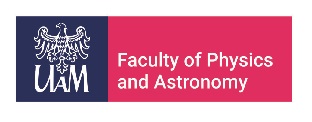Scholarship for PhD student – the project: magnon-phonon coupling in magnetic 2D heterostructures
We are looking for the graduate student willing to start the PhD studies and involve in the research financed by the National Science Center- Poland in the framework of the project SONATA Magnon-phonon coupling in Magnetic 2D heterostructures in presence and absence of skyrmion lattice, led by Dr. Bivas Rana form Department of Nanostructures Physics.
Scholarship
The doctoral student receives a scholarship of 5,000 PLN for the three years of the project. The amount of 11.26% will be subtracted from the scholarship for the obligatory fee of the national social insurance system (ZUS).
PhD studies
The competition is addressed to people who plan to start education at the Doctoral School at the University of Adam Mickiewicz in Poznań in 2021/2022 and is an elite path of financing doctoral students beyond the limit of the doctoral school.
Recruitment
Schedule of the Doctoral School enrollment procedure:
- Registration in the Candidate Online Registration system (IRK): 14 July – 31 August, 2021, https://usosirk.amu.edu.pl/en-gb/offer/SD-2021/programme/SD-NFiz-G7/?from=field:DS010605N
- Submission of documents: 14 July – 31 August, 2021
- Selection procedure: 6-10 September, 2021
- Announcement of the list of admitted candidates: 15 September, 2021
Project description:
There is a growing demand for the smaller, smarter, faster and energetically efficient miniaturized high frequency microwave devices. To fulfil these requirements an alternative technology, beyond the present CMOS technology, is urgently required. The wave-or quasiparticle-based information and computation technology was found to be one of the most potential alternatives for non-Boolean logic operations. In this regard, the spin waves (SWs), collective precessional motion of ordered magnetic spins and surface acoustic waves (SAWs), collective oscillatory motion of lattices have emerged as two potential alternatives. These waves are associated with two quasiparticles: magnons and phonons, respectively. The magnon properties can be easily controlled and reconfigured by material, geometrical and external parameters. To further improve the functionality of magnonic devices by removing all the limitations, magnons must be coupled with other quasiparticle such as phonons. One of the major challenges is to enhance the coupling coefficient to ensure back and forth information exchange with high efficiency. Also, the selection of suitable material system with rich and externally controllable properties is equally important. In this regard magnetic 2D materials (M2DMs) and magnetic 2D heterostructures (M2DHs) with various fascinating interfacial and magnetic properties have emerged. The properties of coherent magnons, phonons in M2DHs has not been explored so far. In particular, the synergy of magnon-phonon coupling and the optimization of coupling strength by playing with the properties of M2DHs have never been reported before. Additionally, the presence of another quasiparticle, skyrmions, nanoscale topological chiral spin structures, can enrich the physics and add more ingredients to control magnon-phonon coupling. Here we take the challenge to investigate, control, optimize magnon-phonon coupling phenomena in magnetic M2DHs in the absence and presence of skyrmions with an aim to develop hybrid magnonic devices which will eventually surpass the speed, efficiency, functionality and integration density of the present CMOS technology. The scientific results will be published in high-quality international journals and disseminated through conference presentations. The young researchers involved in the program will receive extensive training in research and exposure to international research, and culture through international visits. The PhD student will be involved in fabrication of magnetic 2D materials, magnetic 2D heterostructures, patterned samples and devices in collaboration with Prof. Mutta Venkata Kamalakar in Uppsala University. He/she will visit Uppsala University for about 6 months to fabricate the required devices for the study of the project. He/she will also access the clean room in Wielkopolska Center for Advanced Technologies and collaorate with Institute of Molecular Physics PAN for the fabrication of some magnetic thin films and heterostructures for complementary studies. The student will study and characterize various properties of magnetic 2D heterostructures, such as magnetic, elastic, interfacial, by performing experiments in Uppsala University during the visit and in AdamMickiewicz University, Poznań. In particular, he/she will be involved in the measurements of magnons, phonons, magnon-phonon coupling, magnon-phonon non-reciprocity, proximity effect induced enhancement of SW frequency by performing BLS experiment and vector network analyzer – ferromagnetic resonance (VNA-FMR). The student will also be involved in fabricating M2DHs, non-2D magnetic heterostructures for observing magnetic skyrmions by Lorentz Transmission electron microscope (LTEM) and magneto-optical Kerr effect (MOKE) microscope. He will also be involved in writing manuscript, presenting results in conferences, analyzing experimental data with the help of micromagnetic simulations, theoretical analysis of the interfacial physical properties in collaboration with theoretical groups.
Contact
For more details please contact dr Bivas Rana: bivas.rana@amu.edu.pl

